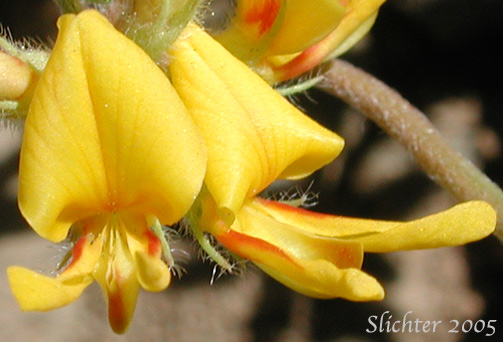
 The
photo at right shows a close-up of the flower of Nevada deer-vetch as seen at
the intersection of roads K6000 and K6900 at about 3510'.........June
12, 2005. Note the narrow wing petals tinged with red or orange at their base,
and the reddish coloration at the tip of the keel. Note also the erect banner
and hairy calyx.
The
photo at right shows a close-up of the flower of Nevada deer-vetch as seen at
the intersection of roads K6000 and K6900 at about 3510'.........June
12, 2005. Note the narrow wing petals tinged with red or orange at their base,
and the reddish coloration at the tip of the keel. Note also the erect banner
and hairy calyx.
Also known as Douglas' lotus, Nevada deer-vetch is a perennial wildflower with numerous spreading or prostrate stems which are freely branched from the base. The stems attain lengths of 20-60 cm and are covered with appressed hairs. The leaves are alternately arranged along the stems and bear 3-5 lanceolate to obovate leaflets with broadly acute tips. The blades typically measure 5-15 mm long and 2-7 mm wide. The petioles measure 2-4 mm long.
The inflorescence consists of 3-20 flowers in a head-like umbel. The peduncles (flower stem) range from equal in length to the leaf blades to twice as long. The pedicels are 1-2 mm long The calyx is 4-6 mm long with the teeth equaling the tube. The outer surface of the calyx is covered with soft, spreading hairs. The flowers are 8-10 mm long and often tinged with reddish to orangish coloration. The banner is erect and often twisted while the narrow wings have margins that are rolled inwards and are longer than the canoe-shpaed keel. The fruits are pods that are up to twice as long (to 6 mm) as the calyx. They are strongly curved or sickle-shaped and covered with appressed hairs.
Nevada deer-vetch is commonly found on dry sandy to rocky soils in forest openings and disturbed areas like roadsides or roadcuts.
Nevada deer-vetch is commonly found on both sides of the Cascade Mts. from southern British Columbia southward to California and eastward to Idaho and Nevada.
In the Columbia River Gorge, Nevada deer-vetch may be found between the elevations of 100'-4000' from adjacent to Crown Point eastward to The Dalles.